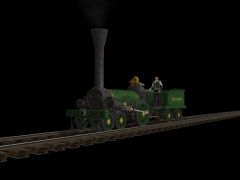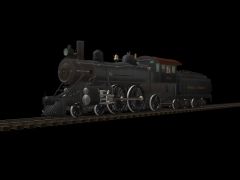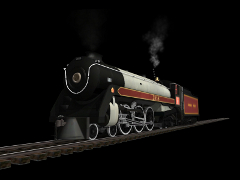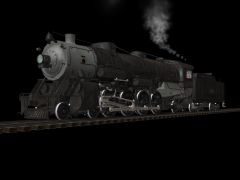|
Home
TC3+
Engines - Standard Gauge
- Switching & Industrial
- Freight
- Passenger & Dual Service
Engines - Narrowgauge
- 30 Inch Gauge
- Other Gauges
Rolling Stock
- House Cars
- Open Cars
- Other Freight
- Passenger
TRS2004
- Narrow Gauge
- Standard Gauge
- Generic
Source Files
Workshop
E-mail
|
Motive
Power: Passenger and Dual Service
Here you will find dedicated passenger power and dual service engines. Dual service engines typically had smaller drivers than dedicated passenger power did, sacrificing raw speed for increased pulling power.
All assets on this page are error-free in TS2012 and should work in TS2009 and TS2010 as well. Reskins are not only permitted, they are actually encouraged. All assets on this page are governed by this license: Feel free to reskin this and release it when and wherever you like as freeware. All I ask is that you indicate where to find the original package and also include the original readme which credits the authors who have contributed to the creation of this asset. This asset may not be used by any payware content without permission.

|
Norris Type A (4-2-0)
Norris Locomotive Works was a relatively short-lived, yet significant early locomotive builder in the U.S. The engine which put them on the map was their 4-2-0, which was sold to many railroads domestically and abroad between the mid-1830s and early 1840s. Prior to the introduction of the Norris 4-2-0s, American locomotives were far from standardized, crude and experimental. The Norris 4-2-0 design established the rough pattern of American locomotives, with a horizontal boiler, external steam chests and internal bar frames. The design was good for its time, but increasing train sizes over the 1840s saw the 4-2-0s either replaced with 4-4-0s or rebuilt as 4-4-0s. All full-size examples were ultimately scrapped, although a live-steam model produced by Norris Works for King Louis Phillippe exists and is on display at the Conservatoire des Arts et Metiers.
This model represents the seven built for the Baltimore & Ohio between 1837 and 1839.
|
KUIDs
in Package
- kuid2:96914:420:3
- kuid2:96914:421:3
- kuid2:96914:50420:3
- kuid2:96914:50421:3
- kuid2:96914:50422:3
- kuid2:96914:51420:3
- kuid2:96914:55420:3
Required Dependencies
- kuid2:75134:99003:8 (DLS)
- kuid2:60238:54027:1 (DLS)
- kuid:123250:100292 (DLS)
- kuid2:101839:40004:1 (DLS)
|

|
N&W Class J Atlantic (4-4-2)
Around the turn of the century, the Norfolk and Western was seeking faster passenger motive power. The engines in service were several classes of Americans, along with the V and A class Ten Wheelers. In 1903, the railroad purchased a group of six Atlantics, which were assigned numbers 600 to 605 and class J. These Atlantics introduced the N&W to the wide firebox over a trailing truck, which would be employed on many future locomotives. In addition, the class J employed the largest driving wheels that would ever be used on the N&W. In December 1904, the class grew to seven locomotives with the addition of engine 606.
The Atlantic type, while very popular at the turn of the century, quickly fell out of favor due a lack of tractive effort. Only fifty-one percent of the locomotive's weight was on the drivers. The large drivers made the problem worse. As trains grew longer and cars became heavier, most railroads replaced their Atlantics with Pacifics, downgrading Atlantics to local or commuter service. Even though the Pacific type was introduced to the N&W in 1905, the J class continued to operate expresses on the level sections of the system for years, until the introduction of the E3 class Pacifics in the early 1930s. The final J was retired in 1935.
Just as the retirement of a group of 1870s vintage Americans left class J open for the Atlantics, the retirement of the Atlantics left the class designation open for a group of streamlined Northerns put into service between 1941 and 1950.
This model represents #606 as it appeared in 1904.
|
KUIDs
in Package
- kuid2:96914:6060:3
- kuid2:96914:50660:3
- kuid2:96914:50661:3
- kuid2:96914:50662:3
- kuid2:96914:6061:3
- kuid2:96914:50663:3
- kuid2:96914:51606:3
- kuid2:96914:55606:3
- kuid2:96914:990606:3
Required Dependencies
- kuid2:126323:54750:1 (DLS)
- kuid:123250:100292 (DLS)
- kuid:103475:60078 (DLS)
- kuid:103475:60079 (DLS)
- kuid:103475:60042 (DLS)
- kuid:103475:60080 (DLS)
- kuid2:58843:3330:1 (DLS)
- kuid2:75134:99003:4 (DLS)
- kuid2:96914:980000/01/15/16/17/18/23:1 (Marker Pack)
|

|
Canadian Pacific Royal Hudson (4-6-4)
The design for Canadian Pacific's Royal Hudson had its start in the H1a class unstreamlined 4-6-4s built in 1929 and 1930. Additional Hudsons ordered in 1937 (H1c) and 1938 (H1d) saw the introduction of streamlining to the same basic design. On a visit by the royal family in 1939, 2850 pulled the royal train across Canada. Impressed with the engine's performance, King George VI granted the title "Royal" to the streamlined engines in 1939. The Royal Hudsons remained in service into late 1950s. Four engines survived into preservation: 2839, 2850, 2858 and 2860.
This model represents H1d number 2858, which is preserved at the National Museum of Science and Technology at Ottawa.
Model made by Guto (WorkSim.)
|
KUIDs in Package
- kuid2:20556:100173:2
- kuid2:20556:100174:2
- kuid2:20556:100090:2
- kuid2:20556:100092:2
- kuid2:20556:100094:2
- kuid2:20556:100096:2
Required Dependencies
- kuid:182464:70010 (DLS)
- kuid2:155527:100090:1 (DLS)
- kuid2:126323:53050:1 (DLS)
- kuid2:101839:40004:1 (DLS)
|

|
USRA Light Mountain (4-8-2)
During the First World War, the USRA was far more concerned with moving vital war material than moving passengers. As a result, few examples of the four passenger designs (Light and Heavy Pacifics and Mountains) were produced during the period of government control. Only 47 of the Light 4-8-2s were allocated by the USRA. However, even this low value was sufficient to make the Light 4-8-2 the second most common of the USRA passenger designs. Additional copies were produced for at least five railroads in the post-war period. The design was not long-lived as Mountains generally were replaced by Super Power steam designs beginning in the mid-1920s.
This model represents an original built by ALCo for the Missouri Pacific in 1919.
|
KUIDs
in Package
- kuid2:96914:4780:3
- kuid2:96914:504780:3
- kuid2:96914:504782:3
- kuid2:96914:504781:3
- kuid2:96914:4781:3
- kuid2:96914:504784:3
- kuid2:96914:51478:3
Required Dependencies
- kuid2:96914:55479:3 (USRA Cab)
- kuid2:126323:53050:1 (DLS)
- kuid2:126323:54501:1 (DLS)
|

|
N&W Class J of 1941 (4-8-4)
N&W 600 was the first of a series of fourteen J class 4-8-4s built by Norfolk & Western's Roanoke shops. Number 600 rolled out of the shops in October 1941. The 1941 Js were designed to replace various classes of smaller steam (K1s and K2s, primarily) in mainline passenger service. Due to the terrain to be traversed by the class, the N&W opted to equip the class with relatively short 70 inch drivers. The short drivers and high pressure, free steaming boiler combined to make the J class one of the most powerful 4-8-4s built. In testing, the Js were found to be capable of speeds in excess of 100 miles per hour with typical trains.
This model represents 600 after a few years of service.
|
KUIDs
in Package
- kuid2:96914:6050:3
- kuid2:96914:6051:3
- kuid2:96914:50650:3
- kuid2:96914:50651:3
- kuid2:96914:50652:3
- kuid2:96914:50653:3
- kuid2:96914:51605:3
- kuid2:96914:55605:3
- kuid2:96914:990605:3
Required Dependencies
- kuid2:123250:1129:3 (DLS)
- kuid2:126323:53050:2 (DLS)
- kuid2:101839:40004:1 (DLS)
|
|





